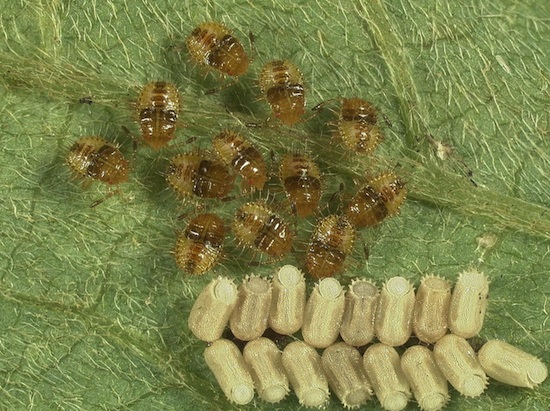Kudzu bugs’ diets consist of mostly kudzu and soybeans, but more and more often they’re getting blamed for devouring all sorts of plants.
The sight of swarming, invasive stinkbugs gives homeowners the impression that the voracious insects will decimate their vegetable gardens and shrubs, but that’s just not the case, said Wayne Gardner, an entomologist with the University of Georgia College of Agricultural and Environmental Sciences.
Kudzu bugs, technically called Megacopta cribraria, were first seen in Georgia in 2009. A member of the stinkbug family, they have green to brown bodies, stipples on their wing covers and wide back ends.
Most of the plants on which kudzu bugs congregate during the spring are simply rest stops on the way to the nearest soybean field or kudzu patch buffet.
“Often times, at this time, they're just sitting around waiting for the kudzu to get tall enough where they can find it,” said Gardner, who helps lead kudzu bug research at UGA. “If homeowners will just be a little bit patient, the bugs will leave.”
Adult kudzu bugs have been known to snack on the leaves of fig trees, hydrangeas and green bean plants — but there’s been no proof that they cause major damage.
They’ll leave as soon as kudzu or soybeans become available to munch on because those are the only plants where their young can survive.
Kudzu bug nymphs inherit two digestive tract bacteria that allow them to digest kudzu or soybeans, but nothing else. Consequently any eggs laid on alternate plants won’t develop into adult insects.
“They’re not going to spend a lot of time where their young have no chance of survival. These guys are very focused on eating and reproducing,” Gardner said.
Gardner’s team helps operate a kudzu bug website — www.kudzubug.org — with all sorts of information on the kudzu bug and its occurrence. The public can even report where they’ve seen the insect and help scientists track the spread of the invasive species.
A lot of the reports come in with notes about what people have tried to use to kill the insect. This worries Gardner.
“(Homeowners) get alarmed by the number of insects that they're seeing because they will just flood you,” Gardner said. “We get reports with notes about what people are doing to get rid of them saying, ‘We’re putting Sevin dust out over all our bushes.’”
“And we’re thinking, ‘Holy mackerel. If they would just wait a little while, these swarms will move over to the kudzu.’”
One plant that seems to attract more kudzu bugs then others is the fig tree.
“We're getting a lot of reports this spring of people being concerned about the kudzu bugs on their fig trees, from Georgia as well as North Carolina, South Carolina and Alabama,” he said.
Entomologists have known about the fig tree swarm phenomenon since 2010, and they haven’t heard of anyone loosing figs to the insects.
“If you're not getting any loss of any of your product, there's no need for spraying,” he said. “All you’re doing is adding an insecticide to the environment and directly to a food product that you want your family to enjoy … If you’re looking for a threat to your figs, the biggest fig problem we have in Georgia is birds.”









